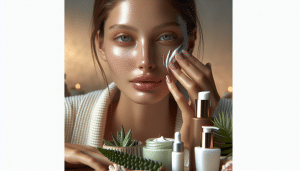Secrets You Might Not Know About Skin Barrier Health
Natalie Brooks September 3, 2025
Curious about what makes glowing skin possible? Discover how maintaining your skin barrier influences radiance, tackles sensitivity, and even supports hydration routines. Explore which ingredients, rituals, and myths matter most when building a stress-free approach to wellness and beauty.
Why the Skin Barrier Is Your Wellness Foundation
The skin barrier serves as your body’s first line of defense against environmental stressors, allergens, and pollutants. Often called the moisture barrier, this invisible shield keeps irritants out and vital water in. When functioning properly, it locks in hydration and protects against dryness, sensitivity, and premature aging—making it crucial for both comfort and confidence. Many beauty experts link glowing skin directly to a balanced, strong barrier, signaling the importance of daily support.
A weakened skin barrier typically results in dullness, tightness, flakiness, and increased sensitivity. Everyday actions—such as over-cleansing, excessive exfoliation, or harsh soaps—can inadvertently compromise this protective layer. Research points out that chemicals in pollution may also disrupt the barrier over time, especially if skin is not properly cared for after exposure (https://www.ncbi.nlm.nih.gov/pmc/articles/PMC5849435/). Awareness of these risks helps shape a proactive approach for healthy skin longevity.
Those who experience sudden irritation or stubborn redness may be witnessing signs of a compromised barrier. It’s not just an aesthetic issue—a weakened barrier can lead to further issues like eczema flare-ups or even acne. By understanding its role in both wellness and beauty, individuals learn why proper barrier care is foundational for every skin type.
Building a Routine That Reinforces the Barrier
A pragmatic approach to skin health involves consistent, gentle routines. Cleansers with a low pH, for example, help maintain your skin’s acid mantle, which is vital for keeping the barrier intact. Avoiding products with drying alcohols or unnecessary fragrances reduces the chance of moisture loss or inflammation. Many dermatologists recommend applying a fragrance-free moisturizer containing ceramides—these lipid molecules help replenish the natural shield and have science-backed efficacy for all skin types.
Layering hydration is a strategy that many find transformative. Serums enriched with hyaluronic acid or niacinamide offer dual support: they hydrate deeply while targeting visible redness or irritation. Moisturizers with squalane and glycerin further draw water into the skin while reducing the appearance of fine lines. Taking a minimalist approach—fewer products, thoughtfully chosen—often yields more consistent results, especially for those prone to sensitivity.
Sunscreen is a non-negotiable part of any skin wellness plan. UV exposure is one of the most common culprits behind a disrupted skin barrier. Using a broad-spectrum sunscreen daily, even when indoors, preserves the integrity of your skin and prevents dehydration (https://www.aad.org/public/everyday-care/sun-protection/sunscreen-how-to-apply). Readers who have struggled with dry patches or slow recovery from breakouts often find that diligent sunscreen use marks a turning point in their barrier health journey.
Spotlight on Ingredients: What to Seek and What to Sidestep
Ingredient awareness makes a notable difference in sustaining a healthy skin barrier. Ceramides, fatty acids, and cholesterol mimic naturally occurring skin lipids, fortifying the barrier even after it’s stressed by weather or aggressive treatments. Glycerin and panthenol are gentle humectants that lock moisture in and shield vulnerable skin from external stressors (https://www.ncbi.nlm.nih.gov/pmc/articles/PMC4324348/). Selecting formulas containing these ingredients optimizes recovery and maintenance, particularly after skin irritation or barrier-compromising episodes.
Conversely, certain ingredients may sabotage improvement efforts. Avoiding denatured alcohol, synthetic fragrances, and abrasive physical exfoliants reduces inflammatory triggers for many skin types. In some cases, even popular acids must be used with caution—overuse of alpha hydroxy acids (AHAs) or retinoids without adequate hydration can impair the skin’s natural repair system. By reading ingredient lists and favoring simplicity, individuals take proactive steps toward resilient, beautiful skin.
Some skincare devotees incorporate antioxidants like vitamin C or green tea extract for added environmental support. These ingredients neutralize free radicals created by sun and pollution exposure, reducing the likelihood of long-term barrier damage (https://www.ncbi.nlm.nih.gov/pmc/articles/PMC3583891/). By pairing antioxidants with gentle protective formulas, overall skin vitality can noticeably improve within weeks.
Common Myths and Surprising Truths
Many myths surround barrier repair, often confusing users. One mistake is believing that more exfoliation always leads to brighter skin. The reality? Over-exfoliating strips protective oils, undermining both the look and feel of healthy skin. Instead, focus on restoring hydration and using gentle acids only as needed. Another myth is that oily skin doesn’t require moisturization. In truth, skipping moisturizer can force the barrier to overproduce oil, sometimes worsening acne or congestion.
Those with sensitive skin sometimes avoid all skincare actives, fearing irritation. Yet, barrier-safe actives like niacinamide or panthenol offer valuable rewards without the risks associated with potent retinoids or acids. One overlooked fact: even stress can erode the barrier over time by increasing cortisol production, which contributes to dryness and reactivity. Practices like proper sleep hygiene and stress management are as important to the skin as what is applied topically (https://www.health.harvard.edu/staying-healthy/the-cortisol-connection).
“One-size-fits-all” approaches rarely yield sustainable improvements. Skin changes with season, age, and environmental shifts. That’s why flexible, responsive routines—guided by understanding and observation—offer the most reliable pathway to healthy barrier function and luminous skin.
Wellness Rituals That Go Beyond Skincare Products
Barrier health isn’t limited to the bottles on a bathroom shelf. Diet, fluids, and lifestyle practices deeply influence the skin’s ability to repair and protect itself. Eating foods rich in omega-3s and antioxidants—such as fatty fish, nuts, fruit, and green vegetables—gives skin the building blocks it needs for both structure and resilience. Drinking water throughout the day helps maintain internal moisture, especially in dehydrating climates or after exercise (https://www.eatright.org/food/nutrition/dietary-guidelines-and-myplate/skin-health-and-nutrition).
Daily wellness rituals such as meditation, gentle movement, and restful sleep help manage the external and internal stresses that can weaken the skin barrier. Poor sleep quality has been linked to waning barrier integrity, more frequent breakouts, and repair delays. Consistently practicing mindfulness or spending time outdoors supports psychological balance, which translates to fewer skin flare-ups and calmer complexions.
Even simple habits like hand-washing with a moisturizing soap or limiting long, hot showers make a difference. Individuals who approach wellness as a holistic, interconnected effort—incorporating sleep, nutrition, stress care, and balanced routines—notice lasting improvements to how their skin looks and feels, beyond what topical products alone can offer.
Red Flags: When Your Barrier Needs Extra Attention
Sometimes, symptoms develop that signal your barrier needs targeted support. Persistent redness, new sensitivity to temperature or wind, increased itchiness, or a burning sensation after using basic products are all red flags. These changes might follow aggressive treatments, new environments, or periods of high emotional stress. Ignoring these signs can amplify complications, making recovery slow and frustrating.
If frequent flare-ups of eczema, breakouts, or hives occur, this could point to underlying barrier dysfunction. In such cases, dermatologists recommend stripping routines back to gentle, non-irritating basics. Applying a ceramide-rich balm, for instance, promotes barrier healing and creates a calming sensation during recovery (https://www.aad.org/public/diseases/eczema/childhood-eczema/skin-barrier).
For recurring or severe issues, consulting a board-certified dermatologist is wise. Sometimes underlying health conditions like allergies, hormonal changes, or medication side effects can compromise the skin barrier. Early recognition and gentle treatment are essential for returning to healthy, luminous skin without prolonged discomfort.
References
1. Draelos, Z.D. (2018). The science behind skin care: Moisturizers. Retrieved from https://www.ncbi.nlm.nih.gov/pmc/articles/PMC5849435/
2. American Academy of Dermatology. (n.d.). Sunscreen: How to apply. Retrieved from https://www.aad.org/public/everyday-care/sun-protection/sunscreen-how-to-apply
3. Schalka, S. et al. (2014). Moisturizers and the skin barrier. Retrieved from https://www.ncbi.nlm.nih.gov/pmc/articles/PMC4324348/
4. Pullar, J.M., Carr, A.C., & Vissers, M.C.M. (2017). The roles of vitamin C in skin health. Retrieved from https://www.ncbi.nlm.nih.gov/pmc/articles/PMC3583891/
5. Harvard Health Publishing. (n.d.). The cortisol connection. Retrieved from https://www.health.harvard.edu/staying-healthy/the-cortisol-connection
6. Academy of Nutrition and Dietetics. (n.d.). Skin health and nutrition. Retrieved from https://www.eatright.org/food/nutrition/dietary-guidelines-and-myplate/skin-health-and-nutrition








